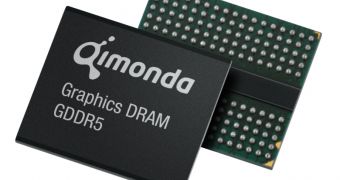As most of you already know by now, AMD is the first graphics card manufacturer to introduce a GDDR5-enabled card. However, the one thing that might have gone by unknown in this is that AMD succeeded this by partnering with memory chip maker Qimonda, which, back in May, announced that it had started shipping GDDR5 memory chips to the Sunnyvale company.
On that note, the company has recently announced that it feels confident about future of GDDR5 memory and that it has big plans with the upcoming lineup based on it. The European manufacturer intends to stay ahead of its competitors and to continue delivering GDDR5 chips. Although the company's biggest client is currently AMD, things might soon change, especially since Qimonda has already announced that it is working on the introduction of higher-capacity chips. In fact, the 1GB GDDR5 chip is scheduled for an autumn arrival, which can't be but great news for AMD.
The company's memory chips are currently being used in AMD's current flagship graphics card, and speculation has it that the same will occur with the upcoming HD 4870 X2 as well. In fact, the new card will provide its users with 2GB of memory from Qimonda's new memory standard - one that comes with higher bandwidth and lower power requirements, all of which are features that, sometime next year, will turn the GDDR5 into the mainstream graphics memory.
And that's not all: GDDR5 will be present in all of the future high-end graphics cards, as NVIDIA is also said be working to equip the new GeForce cards with it. So, we can easily say the future looks very sunny as far as the memory manufacturer is concerned - as it should, since it was Qimonda that first introduced the GDDR5 on the market.
On the other hand, it is yet uncertain whether these new GDDR5-enabled graphics cards will be able to compete with Intel's highly anticipated Larrabee. That is because all the ongoing rumors claim the latter's new chip will bring a whole new level of performance in the graphics department, one that will eclipse current graphics cards.

 14 DAY TRIAL //
14 DAY TRIAL //